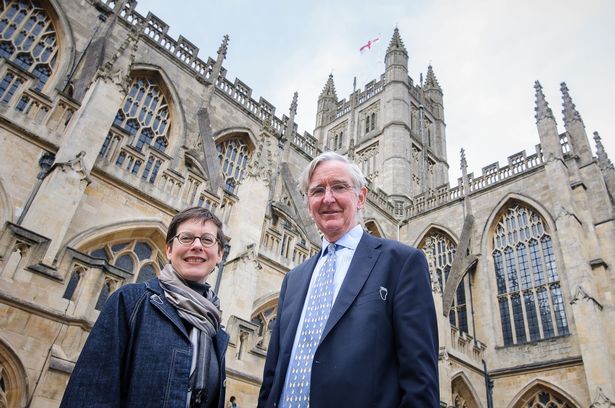Stunning 13th century tiled floor uncovered below Bath Abbey

Stunning 13th century tiled floor uncovered below Bath Abbey
In finding a beautiful tiled floor under Bath Abbey in the 13th century, archaeologists made a “once-in-a-lifetime find”
Around two metres below the current abbey floor level, the vividly coloured tiles were discovered and have not been seen in 500 years.
They give a unique glimpse of what would have looked like inside the grand Norman cathedral, which once stood on the site.
They were found during renovation work for the Footprint project of Bath Abbey to instal a modern eco-friendly heating system using the special hot springs of Bath as an source of energy. Director of the project Charles Curnock said: “It’s amazing.

“We knew there was a floor down there but in a couple of places that we’ve been done [and seen] already, there have been nothing of significance at all, just ordinary stone if that.
“So seeing these tiles is just amazing.” Cai Mason, senior project officer for Wessex Archaeology which is excavating the site, said: “For the archaeologists involved this is probably a once-in-a-lifetime find.
“The trench in which the tiled floor was discovered was excavated during vital repair and stabilisation work to the abbey’s collapsing floor.”
“The work is part of the £19.3 million Heritage Lottery-supported Footprint Project which will also create new spaces and facilities for the community and install an eco-friendly heating system using Bath’s famous thermal spring.”
The 700-year-old floor is currently being painstakingly recorded by the archaeologists and will eventually form part of a 3D model encompassing all the excavations within the abbey.
The tiles will be preserved in situ; covered by a protective membrane and a layer of inert sand before the floor layers are built back up again to their present level.
Mr Curnock said: “We have been surprised and thrilled by the beautiful medieval tiles that Wessex Archaeology have just found as they dig down through the different layers of history below the floor.
“We have always known that before the current Gothic church was built there stood a Norman Cathedral and before that an Anglo-Saxon monastery.
“Lifting the pews and repairing the floor as part of the Footprint project is a once-in-a-lifetime opportunity; it will mean that we can maintain and make improvements to this beautiful building, and change how it can be used to better serve the city, visitors and future generations.

“However, a massive bonus is that it has allowed us to discover important parts of the heritage; things like these beautiful tiles which are being seen for the first time in centuries.
“If it wasn’t for the work carried out for the Footprint project we would have no idea they were here.”
About the medieval floor
The floor is composed of exquisite tiles which are attributed to the Wessex School; a series of designs derived from tiles laid at Clarendon Palace, east of Salisbury.
Other examples of these tile designs are known from Bath, Wells, Bristol and Glastonbury.
The three golden lions on a red shield is the coat of arms of the Plantagenet kings.
The three red chevrons on a gold shield is the coat of arms of the de Clare family, powerful Norman marcher barons who held the earldoms of Gloucester and Hertford as well as land in both Wales and Ireland.
The family line came to an end when Gilbert de Clare, 8 Earl of Gloucester and cousin of Edward II, died at the Battle of Bannockburn in 1314.
How the abbey was built
Construction of the vast Norman cathedral began in 1088, following a rebellion against the succession of William II, ‘Rufus’, which had led to the town and the abbey being ransacked and burned.
The new building was on such a massive scale that the present abbey fits snuggly within the cathedral’s nave.
By the late 15th century the cathedral and the cloistral buildings were described as being in a ruinous state.
Bishop King embarked on rebuilding the church in an ambitious and distinctive new style and, although not consecrated, the building was substantially complete by the time of the Dissolution of the Monasteries under Henry VIII in the late 1530s.
Behind-the-scenes tours
Anyone interested in finding out more about the Abbey’s Footprint Project will be able to book a place on Behind the Scenes Tours which are taking place from September 13 to 15, as part of Heritage Open Days.

It is a rare chance to visit parts of the abbey that are now off limits to the public, discover just why the floor is collapsing and the complex work carried out to repair it as part of Footprint, as well as seeing first-hand what the Wessex Archaeology team have uncovered along the way.
Mr Curnock added: “Maybe in the future we’ll have copies of them for sale in the abbey shop as coasters and mugs and that sort of stuff.
“It’s just an amazing bit of history which we can record.
“The current floor level is about 2m up from where that Norman floor level was so in that area, who knows what we’ll find.”